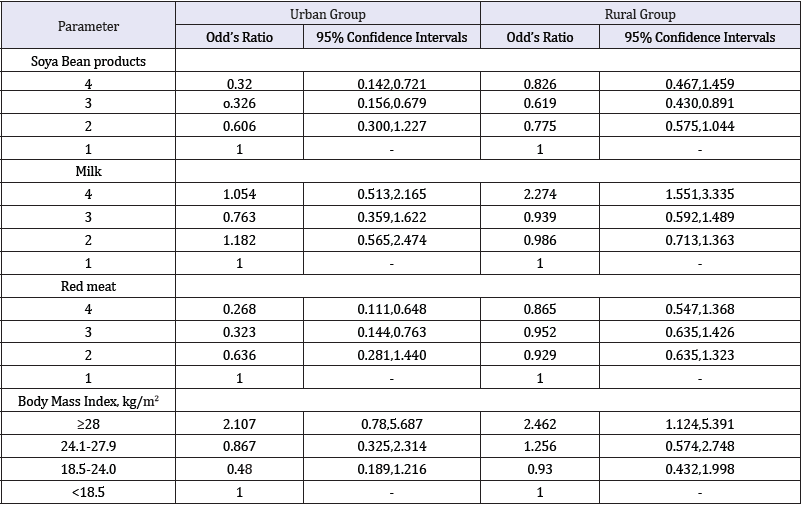- Submissions

Full Text
Novel Techniques in Nutrition and Food Science
Red Meat and Cancer
Yan Huang*
ANSC-Animal Science, University of Arkansas Fayetteville, USA
*Corresponding author:Yan Huang, Assistant Professor, ANSC-Animal Science, University of Arkansas Fayetteville, Arkansas, USA
Submission: March 31, 2018;Published: August 30, 2018

ISSN 2640-9208 Volume2 Issue4
Opinion
On 29 Oct 2015, the International Agency of Research on Cancer (IARC), the cancer agency of WHO, released an evaluation report of the Carcinogenicity of Consumption of Red and Processed meat on The Lancet Oncology [1]. Red meat consumption is classified as probably carcinogenic to humans (Group 2A), based on limited mechanistic evidence that red meat can be associated with colorectal, pancreatic, and prostate cancer. Processed meat was classified as carcinogenic to humans (Group 1), based on enough evidence that it causes colorectal cancer. Compared to the wellknown association between nitrite in processed meat and cancer in humans, which has been well studied for decades, the connection between red meat and cancer is a relatively newer topic of human nutrition and public health.
Recently a research group in Shandong University published a research report about Risk Factors for Breast Cancer in Women Residing in Urban and Rural Areas of Eastern China on Journal of International Medical Research [2]. Over the past decades, the breast cancer incidence in eastern China has been a sharp increase. And it has been shown to be lower in rural areas than urban areas. But between 1993 and 2008, the increase in breast cancer incidence in a rural area was 8.9%, while in urban areas it was only 3.7%, which means the gap in breast cancer incidence between rural and urban areas is narrowing. In the recent decades, China has undergone marked dietary changes, switching from a low-fat, vegetable-based diet to a high-fat, protein-based diet. The beef consumption in China has been increasing from 1 to 6 million tons per year between 1990 and 2010 [3]. Therefore the study of the association between diet changing and cancer incidence is important.
In this study, 122,058 women between ages 25 to 70 participated the survey and physical examinations for breast cancer. Results showed that breast cancer patients have those things in common: older (>45yr old), higher BMI (>24.1), mostly postmenopausal, and more frequent family history of breast cancer. In diet characteristics, cancer patients have fewer soybean products and more milk consumption. No significant differences were identified for the consumption of red meat, ham, sausage, and vegetables. Among women living in urban areas, breast cancer is relatedto BMI, the number of miscarriages, family history of breast cancer, less consumption of red meat and soybean product, and postmenopausal. In rural areas, breast cancer is associated with age, BMI, number of miscarriages, family history, more consumption of milk, and postmenopausal.
In 2007, the UK Women’s Cohort Study reported a high association between red meat and breast cancer risk in postmenopausal women [4]. However other researchers found there is no significant association. The explanation could be differences between methods for cooking meat [5]. Red meat has nutritional value and contains potential anticarcinogenic factors such as selenium, vitamin Bs and D, omega-3 polyunsaturated fatty acids and conjugated linoleic acid. The interesting point in the previously mentioned study of Eastern China, is that in urban women, the red meat has a protective effect against breast cancer. This finding indicated that urban residents select more meat from broader resources or providers with a lower proportion of saturated fatty acids, and cook the red meat more appropriately, to avoid heterocyclic amines and polyaromatic hydrocarbons produced from fried or barbecued red meat.
Table 1:Subgroup analyses of relative risk estimates for the associations between body mass index and the consumption of soya bean products, milk and red meat and breast cancer incidence in women living in urban and rural areas of Eastern China.

For dietary elements 4: eats nearly every day (5-7 days per week);3: eats 3-4 days per week 2: eats 1-2 days per week;1, almost neve eats.
There is no doubt that red meat is related to some cancers in certain conditions. However, a lot of other factors such as age, menopause, red meat source, cooking methods, amount of intake, and lifestyle, should be considered to build the bridge between red meat consumption and cancer incidence. When the media explain to their readers what a healthier diet looks like, it is not right to just put an equal sign between red meat and cancer (Table 1).
References
- Bouvard V, Loomis D, Guyton KZ, Grosse Y, Ghissassi FE, et al. (2015) Carcinogenicity of consumption of red and processed meat. Lancet Oncol 16(16): 1599-600.
- Wang F, Yu L, Wang F, Liu L, Guo M, et al. (2015) Risk factors for breast cancer in women residing in urban and rural areas of eastern China. J Int Med Res 43(6): 774-789.
- Larsen J (2013) China’s growing hunger for meat shown by move to buy smithfield, World’s Leading Pork Producer. Earth Policy Institute.
- Taylor EF, Burley VJ, Greenwood DC, Cade JE (2007) Meat consumption and risk of breast cancer in the UK Women’s Cohort Study. Br J Cancer 96(7): 1139-46.
- Kabat GC, Cross AJ, Park Y, Schatzkin A, Hollenbeck AR, et al. (2009) Meat intake and meat preparation in relation to risk of postmenopausal breast cancer in the NIH-AARP diet and health study. Int J Cancer 124(10): 2430-2435.
© 2018 Yan Huang. This is an open access article distributed under the terms of the Creative Commons Attribution License , which permits unrestricted use, distribution, and build upon your work non-commercially.
 a Creative Commons Attribution 4.0 International License. Based on a work at www.crimsonpublishers.com.
Best viewed in
a Creative Commons Attribution 4.0 International License. Based on a work at www.crimsonpublishers.com.
Best viewed in 







.jpg)






























 Editorial Board Registrations
Editorial Board Registrations Submit your Article
Submit your Article Refer a Friend
Refer a Friend Advertise With Us
Advertise With Us
.jpg)






.jpg)














.bmp)
.jpg)
.png)
.jpg)










.jpg)






.png)

.png)



.png)






